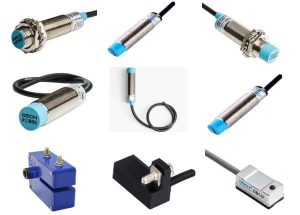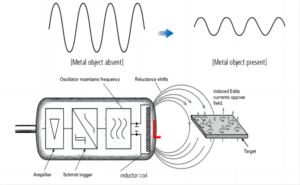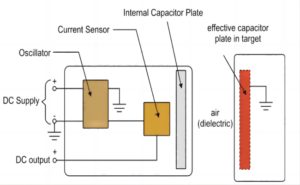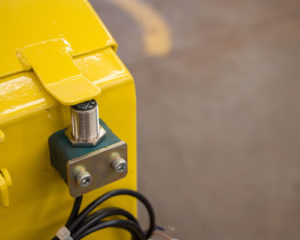What is a Proximity Sensor?

One of the simplest things a proximity sensor does is give a straightforward yes or no signal, like flipping a switch on or off, which we often see as a 1 or a 0. This kind of clear-cut signal is a breeze to work with, especially when hooking it up to different electronic systems. It’s all about action and reaction. For instance, on a factory line, if a proximity sensor spots a part on the conveyor, it can tell the control system to kick off a specific task, maybe starting a weld or putting pieces together.
The versatility of these sensors, coupled with their ability to provide immediate feedback on the presence or absence of objects, makes them invaluable to modern industry, contributing significantly to automation and safety.
Type of Proximity Sensors: Working Principles and Features
Inductive Proximity Sensors

When the sensor picks up on this change, it figures out there’s a metal object in the area it can sense and sends out a signal. This signal usually switches from off to on (or from 0 to 1), and systems connected to the sensor can use this info to do things like stopping a conveyor belt or letting someone know a part has arrived for assembly. The way these sensors switch signals is straightforward and reliable, making them super important in places where finding metal is key.
However, how far these sensors can sense isn’t the same all the time—it can change based on what the metal object is like and how big it is. Usually, they’re good at sensing objects from really close, up to about 60 mm away. What the object is made of makes a big difference, too. Metals like steel that magnets like a lot can be sensed farther away than metals like aluminum, which don’t create strong currents and need to be closer to the sensor. This difference in how they sense things means you have to be careful when choosing and placing these sensors for your needs, making sure they match what you’re trying to detect.
Capacitive Proximity Sensors

These changes in capacitance mess with how the oscillator works, either changing its frequency or how strong its signal is. The sensor’s detection system keeps an eye on these changes and, when it notices something big has changed, it tells the output part of the sensor to switch up its signal. This switch is usually from off to on, which means the sensor has noticed something in its space. One cool thing about capacitive sensors is they can be tweaked to be more or less sensitive, letting them spot a wide variety of materials from different distances. They can detect things from just a few millimeters away up to about 40mm, depending on what the object is made of and how big it is.
Magnetic Proximity Sensors
Now, the distance at which these sensors can spot something magnetic isn’t super long – we’re talking about just a few millimeters to maybe a couple of centimeters. It really depends on how strong the magnetic field is and how sensitive the sensor is. You’ve got to be a bit careful with them because other magnetic fields hanging around can throw off their game. That means placing and adjusting them just right is pretty important, especially if you need them to be reliable in tough situations. Magnetic proximity sensors are highly valued in environments where durability and reliability under harsh conditions are paramount.
Ultrasonic Proximity Sensors
Unlike inductive and capacitive sensors, which offer a simple on-off output, ultrasonic sensors provide a continuous stream of data. This data reflects the varying distances of detected objects. Their prowess is evident in tasks that demand accurate distance measurements, efficiently covering a range that can stretch up to several meters. However, this range isn’t constant; it’s shaped by the sensor’s design, as well as the size and surface features of the target object. This synergy of design and environment determines the sensor’s ultimate effectiveness in gauging distances.
Photoelectric Proximity Sensors
How they work is simple: they notice changes in light caused by something being there. These changes can flip a switch, telling you if something’s there or not, or they can give you a varying signal that changes with how far the thing is or how it reflects light. Photoelectric sensors are cool because they can sense things really far away – up to tens of meters for some types. But the reflective and diffuse types are better for close-up stuff. The way they work can change depending on the object’s size, shape, and what it’s made of. This makes them super flexible for lots of different uses.
Features of Proximity Sensors
-
Non-Contact Operation: Proximity sensors excel in detecting objects without needing physical contact. This non-invasive approach prevents damage or wear to both the sensor and the objects being detected, ensuring longevity and maintaining the integrity of sensitive materials.
-
Durability and Longevity: By employing semiconductor technology for their output mechanisms, proximity sensors avoid the wear and tear associated with mechanical contact, leading to a significantly extended operational lifespan. This attribute is particularly valuable in harsh industrial environments where longevity and reliability are paramount.
-
Resistance to Environmental Factors: The ability of proximity sensors to perform reliably in environments with high levels of dirt, oil, and moisture distinguishes them from optical detection methods that can be impaired under such conditions. Certain models are encased in materials like fluororesin, offering enhanced resistance to chemicals and corrosive substances.
-
Rapid Response Times: Proximity sensors are known for their quick response to detected objects. This feature is critical in applications requiring real-time data, such as assembly lines or safety mechanisms, where delays in detection could lead to bottlenecks or accidents.
-
Operational in a Broad Temperature Range: The robust design of proximity sensors allows for their operation across a wide temperature spectrum, from as low as -40°C to as high as 200°C. This versatility ensures their reliability in extreme conditions, from cold storage to high-temperature industrial processes.
-
Color and Surface Independence: Unlike vision-based detection systems, proximity sensors are largely unaffected by the color or surface finish of the object being detected. This allows for consistent detection performance across a diverse range of materials and colors.
-
Sensitivity to Surroundings: While proximity sensors offer numerous advantages, their performance can be influenced by the ambient environment, including temperature variations and the presence of nearby metallic or non-metallic objects. This necessitates careful placement and calibration to minimize interference and ensure accurate detection.
-
Variety in Configuration: Proximity sensors are available in configurations that include two-wire systems, where the power and signal lines are integrated. This design simplifies wiring but requires careful installation to avoid damage to the sensor’s internal components. Always ensure a load is present to protect the sensor.
Applications of Proximity Sensor

-
Manufacturing and automation include parts detection, machinery position control, and proper assembly line operation sequence assurance.
-
Automotive Sector: Parking assistance, airbag deployment detection by seat occupancy, and keyless entry system activation.
-
Consumer electronics: In order to conserve battery life and avoid accidental touches, turn off the screens of smartphones and tablets when making calls.
-
Material handling: Sorting, counting, and preventing collisions by detecting item placements on conveyor systems.
-
Security and Surveillance: Identifying unwanted entry or movement, setting off alarms or monitoring systems are all part of security and surveillance.
-
Agriculture: Optimizing the route of agricultural machines by identifying crops or impediments.
-
Robotics: Enabling items to be detected by robots for handling, navigation, and collision avoidance.
-
Healthcare: Tracking component locations to guarantee safe gadget functioning.
-
Elevators and escalators: identifying the locations of elevator cars and people in order to facilitate safe mobility.
-
Doors and gates: Acting without human intervention to open for pedestrians or cars.
Installation and Maintenance Tips for Optimal Sensor Performance
Installation Tips:
-
Choose the Right Sensor: Match the sensor right type with your application needs (material to detect, environmental conditions, sensing range).
-
Optimal Placement: Ensure clear line-of-sight to the target, avoiding obstructions that could interfere with sensor operation.
-
Correct Alignment: Align sensors precisely with the target area for accurate detection.
-
Think About the Environment: Put it somewhere safe from extreme weather, water, and dust. Check its IP rating for toughness.
Maintenance Tips:
-
Regular Cleaning: Keep the sensor’s surface clean to prevent false readings or detection failures.
-
Periodic Testing: Test sensors regularly to verify they are operating correctly and adjust settings as necessary.
-
Protective Measures: In harsh conditions, use protective covers or mounts to shield sensors from damage.
-
Update Firmware: Always keep the software up-to-date for the best performance and new features.
Common Issues and Solutions for Proximity Sensors

-
Cause: Frequently brought on by surrounding items unintentionally stepping into the sensor’s detection zone or by environmental interference like electromagnetic waves.
-
Reposition the sensor away from interference sources or change the sensitivity settings on the sensor. It can also be beneficial to shield the sensor from electromagnetic noise.
-
Cause: May be caused by improper installation, such as putting the sensor in the wrong position in relation to the target or employing a sensor whose detecting range is too short for the intended function.
-
Check the sensor’s alignment and closeness to the target as a solution. Think about moving the sensor closer to the target region or utilizing a sensor with a greater detection range.
-
Cause: Changing environmental factors, such as temperature variations that impact the sensor’s functionality, or sporadic interference from metallic objects could be to blame.
-
Solution: Look for and eliminate anything that could sporadically enter the area of view of the sensor. Make that the sensor is rated for the temperature range of the operating environment. It might also be necessary to recalibrate the sensor to better account for variations in the surrounding environment.
-
Cause: The sensor could not be appropriate for the target’s size and type or the surrounding circumstances.
-
Solution: Pick a sensor whose detecting range is appropriate for the use in question. A longer-range inductive sensor should be taken into consideration for metallic objects. Capacitive or ultrasonic sensors may provide a solution for non-metallic targets.
-
Cause: Metallic objects in the vicinity of the sensor can cause false readings or reduce the effective sensing range.
-
Solution: Reposition the sensor or the metallic objects to minimize their impact. Alternatively, consider using a sensor with a more focused detection field.
-
Cause: Unreliable performance might result from external electromagnetic sources interfering with sensor operation.
-
Solution: To prevent extraneous electromagnetic signals from reaching the sensor or cables, install shielding around them. Improper grounding can also be minimized to lessen interference.
-
Cause: Operating outside the recommended temperature range can lead to sensor malfunction.
-
Solution: Use sensors designed to withstand the specific temperature conditions of the application. Protective housings can also help maintain sensor operation within a safe temperature range.
Which Is Right for Your Application?
|
Feature/Consideration
|
Inductive
|
Capacitive
|
Ultrasonic
|
Photoelectric
|
Magnetic
|
|
Sensing Material
|
Primarily metals
|
Wide range, including non-metals
|
Any material
|
Any material, excels with transparent or reflective
|
Ferrous metals
|
|
Effect of Environment
|
Less affected by non-metallic substances
|
Sensitive to environmental changes
|
Variably affected by air conditions
|
Light conditions can influence
|
Minimal, mainly magnetic fields
|
|
Range
|
Short to medium
|
Short to medium
|
Medium to long
|
Short to long, varies by type
|
Short to medium
|
|
Response Time
|
Very fast
|
Fast
|
Medium
|
Fast to very fast
|
Fast
|
|
Output Type
|
Binary (ON/OFF)
|
Binary (ON/OFF)
|
Binary or analog
|
Binary (ON/OFF) or analog
|
Binary (ON/OFF)
|
|
Susceptibility to Noise
|
Moderate, depends on surroundings
|
Low
|
High, sound-based
|
Low, can be affected by external light sources
|
Low, specific to magnetic disturbances
|
|
Applications
|
Machinery, automotive detection
|
Level sensing, material detection
|
Distance measurement, object detection
|
Packaging, assembly line counting
|
Position sensing, rotation detection
|
FAQs
What is the difference between NPN and PNP output in proximity sensors?
PNP sensors mean Positive-Negative-Positive. They work differently. PNP sensors source current. They connect to the positive side of a circuit when they detect an object. Systems with positive ground use PNP.
Choosing between NPN and PNP depends on the system you have. It’s about how the system uses signals. PNP sensors suit systems that look for high signals. NPN sensors are for those needing low signals.
Unshielded sensors, or non-embeddable, lack this shield. Their sensing area extends beyond the sensor’s front and sides. This makes them more versatile in detecting objects from different angles. But, you need to be careful with their placement. Without the shield, they might sense unintended objects.